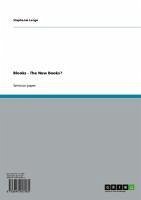Blooks are the new books, a hybrid literary form at the cutting edge of both literature and technology. (Bob Young, founder of the print-on-demand publisher Lulu, 2006) Back in 2006, a phenomenon made its way from the depths of the World Wide Web into the newspapers: the so-called "blook", a portmanteau word composed of the words "book" and "(we)blog", meaning a book written on the basis of a blog. The media were excited about these new kinds of books and looked to Japan, where blooks were already bestsellers. "Blook" even made it into the shortlist of words that were considered to be included in the new edition of the Oxford English Dictionary in 2006 (Philipps 2006). If you search for "blook" on Google in 2010, you are in most cases directed to archives and it will not take you long to find out that blooks have virtually disappeared from the Web. Despite the fact that weblogs keep thriving, blooks seem to be forgotten. Considering this, it is not surprising to find out that no research has been done on blooks, while weblogs have been a subject of research since 2005. Research on weblogs often concentrates on how they changed journalism and communication in general, but never mentions the medium of blooks. Jenna L. Brinning and Jill Walker Rettberg gave good overviews of web-publishing and blogging, with Brinning stressing Habermas' "Strukturwandel der Öffentlichkeit" with regard to the opportunities of the Web and Rettberg taking into consideration the rise of "citizen journalism". This paper will try to find out what happened to blooks not only by examining this medium, but also by taking a look at its origins. The first chapter will deal with the definition of blooks as well as with the history of the so-called "blogosphere" from which the blook emerged. The second chapter will present some successful examples of blooks, show the diversity of subjects they deal with and analyze the reasons for their popularity. Chapter three will focus on marketing strategies and the overall reception of blooks by taking a look at the media coverage and an award especially invented for this genre. The last two chapters will then compare blooks to traditional narratives and eventually draw a conclusion concerning the development of blooks and their potential for success.
Dieser Download kann aus rechtlichen Gründen nur mit Rechnungsadresse in A, B, BG, CY, CZ, D, DK, EW, E, FIN, F, GR, HR, H, IRL, I, LT, L, LR, M, NL, PL, P, R, S, SLO, SK ausgeliefert werden.









